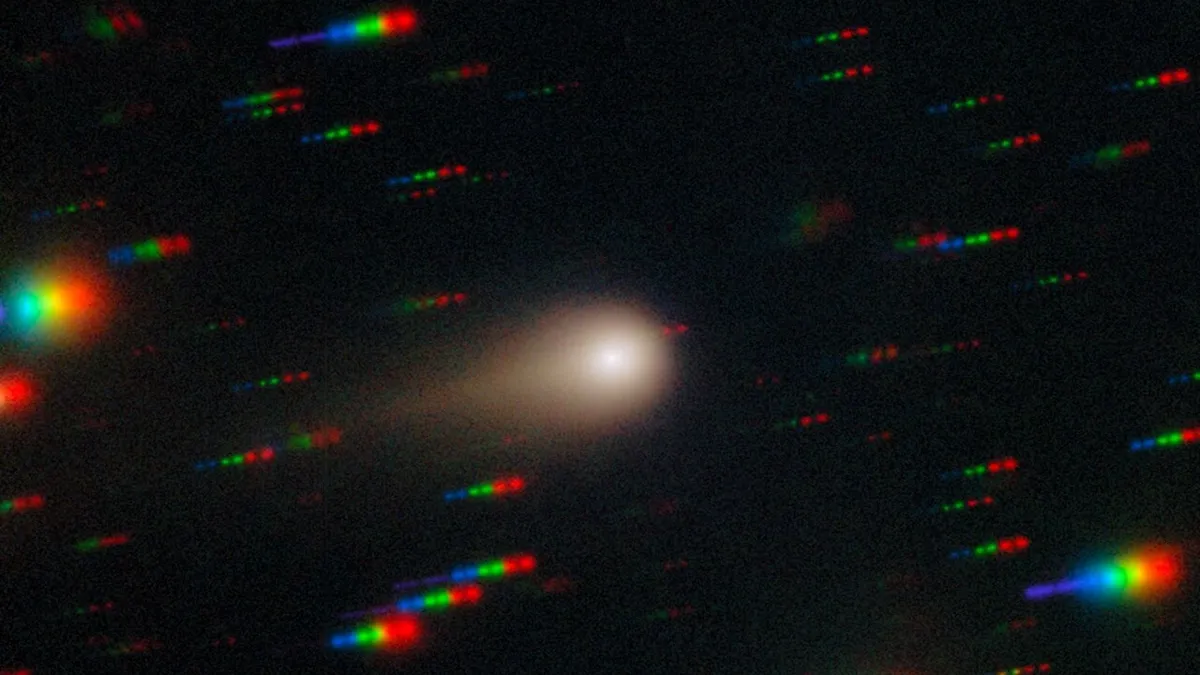
Comet 3I/ATLAS has recently been the focus of groundbreaking research utilizing the James Webb Space Telescope (JWST). Findings reveal that the comet has been heavily irradiated over billions of years due to cosmic ray bombardments. As a result, it has developed a thick irradiated crust, which has altered its original composition, making it differ significantly from the materials of its home star system.
According to the study posted on the preprint server arXiv on October 31, researchers used JWST observations and advanced computer simulations to investigate the comet's unusual characteristics. The research indicates that the comet's extreme levels of carbon dioxide (CO2) enrichment are a direct result of space radiation absorbed throughout its estimated 7-billion-year journey through the Milky Way.
Galactic cosmic rays, which are high-energy particles originating from outside the solar system, interact with carbon monoxide (CO) in space, effectively converting it into carbon dioxide (CO2). In contrast, the heliosphere—the vast bubble of radiation emitted by the sun—provides a protective shield for Earth and its neighboring planets, reducing their exposure to this cosmic radiation. However, during its long interstellar voyage, Comet 3I/ATLAS has not enjoyed such protection.
The study's authors concluded that the bombardment by cosmic rays has profoundly altered the physical state of the ice within comet 3I/ATLAS, affecting depths of about 50 to 65 feet (15 to 20 meters). According to the lead author, Romain Maggiolo, a research scientist at the Royal Belgian Institute for Space Aeronomy, this slow yet significant process over billions of years has transformed the comet's exterior.
The implications of these findings suggest a paradigm shift in our understanding of interstellar objects. Rather than being composed of pristine materials reflective of their original environments, objects like comet 3I/ATLAS are primarily made up of galactic cosmic ray-processed materials, highlighting its transformation during its extensive journey through space.
Currently, Comet 3I/ATLAS is orbiting the sun and reached perihelion, its closest point to our star, on October 29. As the comet approaches the sun, it heats up, causing the ice on its surface to sublimate into gas. The recent findings imply that gases released from the comet prior to perihelion were solely from its irradiated outer shell. This trend is expected to continue post-perihelion, although there is a possibility that solar erosion may expose more pristine materials from its nucleus.
Maggiolo emphasized the importance of comparing data from before and after perihelion to gain insight into the comet's initial composition. "It will be very interesting to compare observations before perihelion with those made after, as any erosion could reveal aspects of its original materials," he noted.
Since its discovery in July, researchers have been utilizing various telescopes to gather data on 3I/ATLAS. Preliminary observations indicate that the comet is traveling at speeds exceeding 130,000 mph (210,000 km/h) along a notably flat and straight trajectory. Some studies suggest that this comet may be the oldest ever observed, potentially being around 3 billion years older than our 4.6 billion-year-old solar system.
This recent research builds upon earlier studies that established 3I/ATLAS as rich in CO2, based on JWST's initial images and data from NASA's SPHEREx orbiter. Maggiolo and his team adapted their existing models, originally developed for a domestic comet, to better understand the effects of cosmic ray exposure on 3I/ATLAS.
By modeling the cumulative effects of galactic cosmic ray exposure, the researchers determined that just 1 billion years of irradiation could create the deep irradiated crust observed in comet 3I/ATLAS. Maggiolo pointed out that while the comet has aged and changed significantly, it still holds a wealth of intriguing information for scientists. "We need to be cautious and consider aging processes in our analyses, but 3I/ATLAS remains a fascinating subject of study," he concluded.